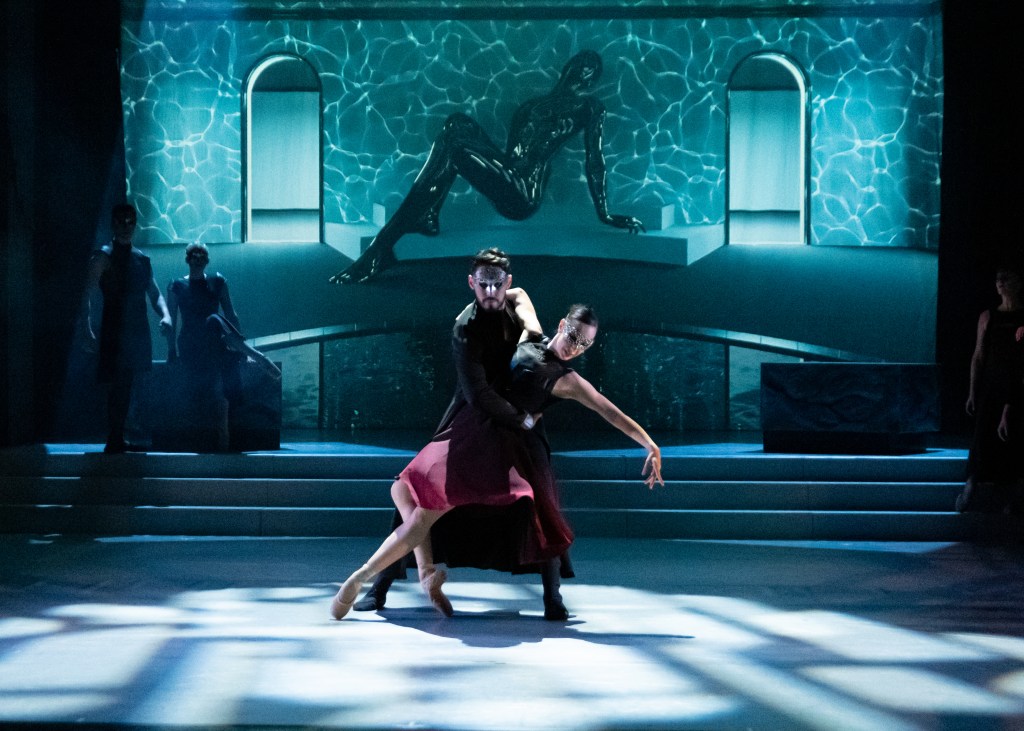When William Shakespeare wrote his tale of star-crossed lovers — one a Montague, the other a Capulet — he didn’t say much about what everybody else in fair Verona was up to. That’s where Chicago Repertory Ballet comes in. The company’s newest production, an evening called “The Capulets” running two weekends in the Gold Coast, extrapolates “Romeo and Juliet” with a vividly imaginative story centering on Juliet’s mom.
It’s not Wade Schaaf’s first flirtation with the Bard. The 13-year-old company’s artistic director produced a balletic version of “Macbeth” almost a decade ago. But “The Capulets” is playing a whole different ball game: Schaaf wrote the libretto, in which Lady Capulet (elegantly danced by Miriam-Rose LeDuc) gets romantically involved with Tybalt after finding out her husband (Rosario Guillen) is sleeping with another man (Paris, danced by Skyler Newcom).
To this, Chicago Repertory Ballet adds immersive projections (John Probojewski and Zach Minnich with technical support from Liviu Pasare), complementary lighting by David Goodman-Edberg, costumes by resident designer Nathan Rohrer and the cherry on top: original music by Chicago-based composer Matty Mattsson. “The Capulets” looks and feels expensive. I’m sure it is, but that’s not quite the point. For this critic, who has watched this company grow into a teenager, “The Capulets” is its first serious, all-in investment in its ambitious vision for Chicago dance. The hypothesis? That the city can support and sustain more than one professional ballet company.
“The Capulets” isn’t conventionally Shakespearean in its aesthetic, though there’s ample sword play and occasional step-touch court dancing. Shakespeare wasn’t shy about injecting a tragedy with moments of levity, which Schaaf picks up on and best exploits with a corps of what appear to be dancing coats of armor donning Geordi La Forge-styled shimmery visors. They pose, audibly ooh-ing and ah-ing at LeDuc and Jackson Ferreira (who gives a strong performance as Tybalt) as they make out in Tybalt’s armory surrounded by swords and knives — as you do.
By the end of the night, I wished there had been even more of these tongue-in-cheek moments, like when Mattsson, whose synthesized score (his first for dance) doesn’t really start cooking until Act 2, dips in and out of themes borrowed from Igor Prokofiev’s 1935 score for “Romeo and Juliet.” This is incredibly satisfying for those who can pick up on it — and creates familiar rhythmic structures for Schaaf to follow. Like the music, the world built by this spectacular creative team isn’t entirely era-specific. Rohrer only hints at Elizabethan garb, adorning each character with subtle clues about which characters are married and which ones are lovers (these aren’t mutually exclusive). The projections, which take full advantage of the Ruth Page Center’s architectural eccentricities, are similarly ambiguous, feeling not fully real or entrenched in a particular time. That’s not a bad thing — it makes for smoother transitions with the projections pause from placemaking (animated drone shots of a fictional Verona, for example, or situating us among those knives and swords in the armory) to explore a more abstract world. A black ink blot bleeds all around when Romeo kills Tybalt, for example (remember that?). And animated text hints at certain plot points, a touch that saturates the visual experience and isn’t, perhaps, totally necessary.
 Wade Schaaf’s world premiere of “The Capulets” by the Chicago Repertory Ballet at the Ruth Page Center for the Arts. (Jorge Sigler)
Wade Schaaf’s world premiere of “The Capulets” by the Chicago Repertory Ballet at the Ruth Page Center for the Arts. (Jorge Sigler)
As for the dancing, Schaaf’s lineage as both a classical and contemporary dancer, most prominently with Thodos Dance Chicago in the aughts, is fully realized in this ballet’s vocabulary — maybe better than any other recent example. Even better, the dancers, a like-minded mix of classical and contemporary specialists, are capable of seamless code-switching between floor work and pointe work, and between the serious and silly.
Not content with letting a tragedy be tragic, “The Capulets’” only forced error is the epilogue, which moves the plot 10 years forward to a country estate where children dressed in all-white frocks dance and play together. It’s adorable. But the story ends with the family living happily ever after, Lord Capulet apparently without his boyfriend and raising his wife and Tybalt’s love child (that also happened). Each family is different, I guess. I hope they’re happy. And in therapy.
Lauren Warnecke is a freelance critic.
Review: “The Capulets” (3 stars)
When: Through Nov. 16
Where: Chicago Repertory Ballet at Ruth Page Center for the Arts, 1016 N. Dearborn St.
Running time: 1 hour, 45 minutes with an intermission
Tickets: $38-$68 at chicagorepertoryballet.com
